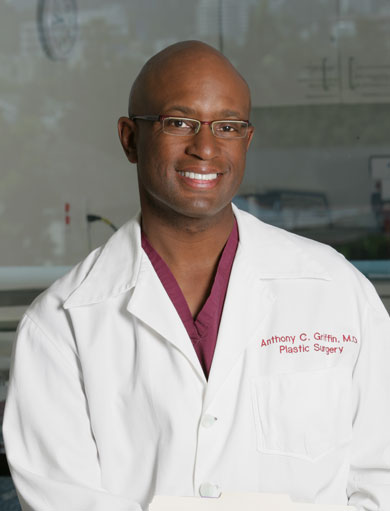Process
Rhinoplasty is one of the most complex cosmetic surgeries. Alterations to the outer contours of the nose are reflected in changes to the nasal anatomy. In all cosmetic rhinoplasty procedures, skeletal support is preserved and the bone and cartilage are remodeled in to a more attractive shape and size. During rhinoplasty Dr. Anthony Griffin, Beverly Hills plastic surgeon, will sculpt the cartilage and bone to achieve the desired result. In the majority of rhinoplasty surgeries both cosmetic and functional issues are addressed.
The Goal
The goal of a rhinoplasty is to correct functional defects that interfere with breathing, and enhance your appearance by creating a nose that compliments your facial structure.
Rhinoplasty can:
- Help you breathe better
- Fix a bump in the nose
- Straighten a crooked nose
- Narrow the bridge of the nose
- Reshape the tip of the nose
- Fix a broken nose
- Adjust the tip of the nose up or down
- Fix the projection of the nose- the amount the nose extends from the upper lip, to reduce or increase the projection
- Reduce the width of the nose and nostrils
- Modify the angle between the nose and upper lip
The Procedure
Rhinoplasty is commonly done as an outpatient. Most likely you will have local anesthesia with a sedative. However, in some circumstances general anesthetic may be the best option. Generally, once anesthetized, Dr. Griffin will make incisions inside the nose (Closed Rhinoplasty), and reshape the bone and cartilage to a more handsome appearance. He will have explained the procedure so you will know what to expect.
Recovery
Your nose may be in a nasal splint, a device that is used for support during the first week after surgery.
It protects your new nose and helps to maintain its new shape. You may also have a cast on your nose. You may also have packing to prevent bleeding. Nasal congestion, headache, swelling and difficult sleep are normal after surgery. Your nose may be numb, but numbness will subside in a few weeks. You may have a pad taped under your nose to catch drips and bleeding. You will be instructed on how to care for your nose before you are discharged.
Swelling and bruising are to be expected. Cool compresses to reduce swelling. Swelling may get worse before it gets better. Most should resolve within the first 2-3 weeks. You will receive pain medication to take as needed. You will also receive a prescription of antibiotics which you should take as directed.
Daily care involves cleaning the suture lines in the nose with a Q-Tip and hydrogen peroxide, after which you will apply antibiotic ointment.
Activity limitations will be explained to you.
The Surgical Approach- Closed or Open Rhinoplasty?
The greatest difference between the open and closed approach is that in the open approach, an incision is made at the bottom of the nose. In a closed rhinoplasty, all surgical incisions and enhancements are made inside the nose. The method chosen depends on the severity of the defects.
Closed Rhinoplasty
Benefits:
- No visible scars
- Decreased operative time
- Faster recovery
- Less downtime
- Less swelling, bruising and pain
- Great for busy people who seek to return to daily life quickly
- Most patients are good candidates
Open Rhinoplasty
Benefits:
- Best for noses that were broken or deformed
- Allows the surgeon greater vision and accessibility
- Good for revision surgery where there is not enough natural strength or available tissue
- Good for nasal tip modifications, particularly where a cartilage graft is needed to support the tip
- Good for repair of septum defects
- Good for patients with thin nasal skin
During a Rhinoplasty the surgeon adds or removes bone and cartilage to alter the form and sometimes the function.
Grafting
A cartilage graft may be used to add volume to fix a depression, remodel the tip, especially where the tip is weak and droopy to provide strength and support for the nasal skeleton. Grafting cartilage can be obtained from the tissue removed while reshaping the nose. If no cartilage is available, it can be from behind the ear.
It will take a year for complete healing when you will see the final shape of your new nose. It is worth the wait! Within 2-3 weeks after surgery you should be able to resume social activities without anyone noticing you had a procedure.
If you are thinking about reshaping your nose, call for an appointment with Board Certified Beverly Hills Plastic Surgeon Dr. Anthony Griffin, to discuss it. He will be able to tell you about your unique facial features and how he can enhance your natural beauty with rhinoplasty.
Book Online
